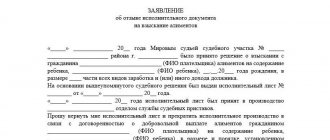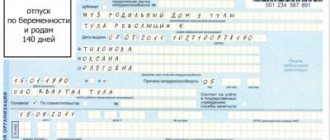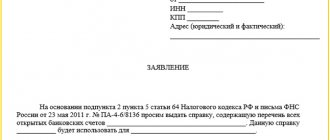How to obtain a writ of execution?
The writ of execution will not appear in the bailiff service on its own. The plaintiff must go to the court office after the completion of the trial to obtain the document. The writ of execution comes into effect only after the court makes a decision or ruling.
In order to receive the sheet in hand, the plaintiff must fill out an application.
In some cases, the writ of execution is sent independently after the trial to the bailiff service. This occurs if the requirements set out in the document must be met immediately. Typically, these requirements must be met on the first day after receiving the writ of execution at the court department.
Procedure for provision
To obtain a sheet, you need to submit a corresponding application to the court that made the decision in this case. It can be filed on his own behalf by the plaintiff or a representative who has a power of attorney to do so. The procedure will be as follows:
- It is necessary to prepare the application itself.
- Submit it in one of the possible ways to the court office.
- Receive the sheet in the way specified in the application.
Accordingly, the most important thing in this procedure is a correctly and legally competent application.
Statement
Ready-made application forms can usually be obtained from the court office. It is best to do this immediately after the court decision is made. But you can also download them on the Internet or fill them out yourself. The most important thing is that the application contains all the necessary information. The algorithm for its compilation is as follows:
- The full name of the court that made the decision is indicated. This is written in the upper right corner.
- Below are the personal details of the applicant and his registration address. It is also advisable to indicate a telephone number for quick communication if necessary.
- Next is the title of the document.
- The body of the application indicates all the details of the court decision, the date of its adoption, and the personal data of the plaintiff and defendant.
- Below you need to indicate that the debtor refuses or cannot voluntarily execute the court decision, therefore its execution is possible only by force.
- Based on this, you need to submit a request to provide a writ of execution. Here it is important to indicate how the applicant wishes to receive this document and the required number of documents.
- Next, it is important to refer to legislative articles 428-429 of the Code of Civil Procedure of the Russian Federation.
- Below is the “Please” paragraph, which specifically states the required number of sheets and the method of receipt.
- The date of application and the signature of the applicant are indicated at the bottom.
Following this algorithm, drawing up this document will not be difficult. It is important to know that you can request several copies of writs of execution, but you must justify why so many documents are needed.
Also important is the method of obtaining this sheet. You can request that it be sent by mail to the applicant himself at a specific address. Or you can request that this document be sent immediately to the bailiffs to initiate enforcement proceedings. In this case, the claimant will not have to independently send this document to the FSSP.
You can also send an application to the court office in several ways:
- personal visit;
- by registered mail with notification.
Read more: How much of a garage sale is tax-free
When visiting the court office in person, you must have 2 copies of the completed application. This will be required so that the employee who accepted the document marks one of them with the date of acceptance.
When sending by mail, one copy will be sufficient, but it is important to send a letter with notification. The returned confirmation of receipt of the application will be confirmation of acceptance of the document.
Validity period of the writ of execution
The effect of a writ of execution depends on its type. Writs of execution are:
- Upon the return of stolen funds, various items and even children;
- When making wage payments to an employee who was illegally dismissed from work;
- When compensating for damage caused by a crime;
- In case of compensation for moral damage.
If the writ of execution is aimed at collecting a debt, then its validity period is about 3 years from the date of the decision during the trial.
Tip 4: How to transfer a writ of execution
Based on this article, when applying to a court in a civil manner, a document to implement the decision will be issued no earlier than ten days after the announcement. If the court decision is executed immediately, then the writ of execution is also issued on the same day.
It is worth immediately paying attention to the fact that the court can oblige both the defendant and the plaintiff to take certain actions (for example, the distribution of legal costs).
Due to the fact that the decision of the ______________ City Court of the Moscow Region has entered into legal force, I ask that you give me a writ of execution in the above case.
You can see for yourself that there is no regulation according to which you can delay the issuance of a writ of execution for another month. Ask the clerk directly for a link to the law.
This is important to know: Deadline for checking a writ of execution by the bank
Validity period of the writ of execution for the collection of alimony
Just like other types, a writ of execution issued for the collection of alimony is valid under the following circumstances:
- If the child has not reached the age of majority;
- If the legal representative has died.
It should be noted that even if the child turns 18, the parent can file a claim for child support on the eve of the birthday. Payments will be made for the past three years. As soon as the child turns 18, the validity period of the writ of execution can be considered completed.
what to do if the writ of execution arrived faster than the appeal
The defendant filed an appeal against the court decision, which was not made in his favor. But before the envelope with the complaint was delivered to the address, the plaintiff managed to present a writ of execution and receive more than 40 million rubles from it.
The appeal overturned the decision, and the winning defendant decided to return his money with interest. Two instances rejected his claims, but the Supreme Court found their findings contradictory.
Haste left me without money
Alexey Moskalenko was the founder of Petro Pak LLC, a company producing corrugated cardboard, paper and cardboard containers. After some time, the businessman left the company, and two new members joined it - Evgeniy Hutte and Oleg Sidash.
Then the company decided to buy assets from Moskalenko. For 50 million rubles.
Expert opinion
Korolev Stanislav Vitalievich
Lawyer with 10 years of experience. Specialization: family law. More than 3 years of experience in defense in court.
the former founder sold the company production premises, as well as machines and equipment for the production of corrugated cardboard. However, Petro Pak later challenged this major deal because Hütte and Sydas allegedly did not approve of it.
Moskalenko objected to this, citing the minutes of the general meeting of participants. The Petrozavodsk City Court took the plaintiff's side and declared the deal invalid.
The minutes do not indicate approval of a specific price for each property. In addition, the enterprise was actually sold based on a number of transactions, the city court decided.
He obliged the parties to the transaction to return to each other everything they received. The reasoned decision was made on December 22, 2014; an appeal could be filed within a month - until January 22, 2015.
Representative Moskalenko did just that - on January 20, he sent a complaint by mail. When it had not yet arrived, on January 23, employees of Petro Pak LLC received a writ of execution and immediately presented it to Petrozavodsk Sberbank for execution.
There, 40.2 million rubles were written off from Moskalenko’s account.
The Petrozavodsk City Court received the complaint only on January 27. The plaintiff and the bailiff service were notified of the revocation of the writs of execution.
And then the Supreme Court of Karelia overturned the decision of the Petrozavodsk City Court and refused to satisfy the claim of Petro Pak LLC. The plaintiff did not provide evidence confirming that instead of a purchase and sale transaction of real estate objects, other actions were taken, the plaintiff did not present, the panel concluded.
Related article: Sequence of deductions across several writs of execution: how to distribute deductions
In addition, she concluded that the founders approved the controversial transaction.
Moskalenko decided to return his money with interest (just over 2 million rubles), for which he filed a lawsuit in the Petrozavodsk City Court against the Ministry of Finance of the Russian Federation, the Department of the Court of Justice in the Republic of Karelia, Sberbank and Petro Pak. The court refused him.
There are no grounds to hold the state responsible, and Petro Pak did not abuse its rights, judge Lena Emelyanova concluded. In her opinion, it was Moskalenko who should have informed the court in time that he had filed an appeal, especially considering that he did not do it in person, but by mail.
The appeal, the judicial panel for civil cases of the Supreme Court of the Republic of Karelia, also agreed with this conclusion.
BC pointed out mistakes
However, the Supreme Court drew different conclusions from the same circumstances. The panel, chaired by Judge Viktor Momotov, reminded that the decision should not contain mutually exclusive conclusions.
But the Supreme Court found them in the decision in the Moskalenko case. On the one hand, the plaintiff lost his money; it was not returned to him, says the court act.
On the other hand, the court did not find evidence that the defendant acted unlawfully and abused his rights.
The legally significant circumstances for the case - the legal relationship of the plaintiff with each of the defendants, the establishment of their guilt, the possibility of imposing liability on them - were not established either by the first instance or the appeal, the Supreme Court noted: they were not included in the subject of evidence in the case and, accordingly, did not receive a legal assessment . In addition, the Judicial Department should have been involved in the case, but no one did this either.
As a result, the Supreme Court canceled the appeal ruling in the case and sent it for a new trial to the appellate court. As of the date of publication of the article, there is no information about a new consideration of the case.
Irina Kondratyeva. PRAVO.RU
Share link:
Similar
How to present a writ of execution to the bailiffs?
There are times when there is no need to contact bailiffs. This usually occurs when the debtor voluntarily decides to pay the debt. However, if this does not happen, then the plaintiff can file the document during the entire period of its validity.
Initially, the plaintiff should submit an application to initiate enforcement proceedings to the bailiff service. It is also necessary to present documents obtained during the trial.
Bailiffs must make a decision on opening an enforcement case within 3 days, and only from this moment the validity period of the writ of execution begins to be calculated.
The bailiff has the right to refuse to reopen the case. This may happen for the following reasons:
- If errors, typos or inaccuracies in facts are found in the received documents. In this case, the plaintiff must again go to court for new papers and only after the judge makes a decision to contact the bailiff again.
The validity period of the writ of execution begins 3 days after the bailiffs receive a new package of documents.
The production process itself can last about 2 months. However, there are cases where the deadline may be changed. This happens in the following cases:
- If the validity period of the writ of execution is fixed on the document itself;
- If one of the bailiffs instructed the other to perform a number of enforcement actions. Thus, it is given about 15 days to complete. In this case, the period begins to be fixed from the moment the instructions are transmitted.
In addition, upon receipt of the writ of execution, the bailiff must make a decision to reinstate the debtor to his previous place of work. This must be done the next day after the bailiff receives the writ of execution. Also, if a writ of execution is received on the basis of a claim, then all demands must be fulfilled the next day.
Cases from the practice of the bailiff service
The writ of execution is the most important document that must be received and presented to the FSPP within the time period established by law. But in practice, situations often occur when, due to some errors, a violation of the current legislation occurs. Most often, when filling out a writ of execution, mistakes are made in the name, surname or patronymic of the claimant or debtor.
Thus, citizen Yu. applied to the court office in order to obtain a writ of execution in order to collect a debt from the defendant in a property dispute. He did not read the document carefully and handed it over to the FSPP. In the office of the bailiff service, the collector hastily filled out an application, indicating the debtor's last name with an error.
Afterwards, the bailiff initiated enforcement proceedings at the request of the claimant, taking from there information about the plaintiff and defendant. The resolution to initiate enforcement proceedings was sent to both the address of the claimant and the address of the debtor, whose last name was indicated in the application with an error. The debtor did not appear at the FSPP service on the day appointed by the bailiff.
Having gone to the debtor's address, the bailiff learned that enforcement proceedings had been initiated based on an application that contained erroneous information about the debtor. Because of this, the bailiff will not be able to carry out the collection procedure.
In order to receive a new writ of execution, you must attach the original of the previously issued writ of execution to the application for correction of errors.
It is errors that lead to a delay in issuing the writ of execution. When submitting an application for a writ of execution, it is important to check the following data:
- surname, name and patronymic of the parties to the dispute;
- presence of the date of issue of the court document;
- correspondence of the number and content of judicial proceedings;
- the exact date of entry into force of the court decision;
- the presence of a clear resolution of the court;
- coincidence of the name of the court and its legal address.
If inaccuracies and errors are discovered in the writ of execution, you should immediately contact the court that issued it. If the presence of an error in the writ of execution affects the execution of the court decision, then an application is submitted to the court office to correct the error in the writ of execution. In this situation, adjustments will also be made to the issuance deadlines.
Delay in fulfilling the requirements of the writ of execution
There are cases when a bailiff can suspend the deadlines for fulfilling requirements drawn up in a writ of execution. These reasons may be:
- The debtor is performing military duty or is on a long business trip;
- The debtor has become incapacitated and is not subject to jurisdiction;
- In the event of the death of the debtor;
- The debtor tries to challenge the requirements specified in the writ of execution;
- The debtor began a case to appeal the legality of the trial and the actions of the bailiff.
Payment according to writ of execution
As mentioned just above, the debtor can voluntarily, within 5 days from the moment he became aware of the opening of an enforcement case against him, comply with the decision of the court, without waiting for forced execution.
We are talking about payment according to the writ of execution
If the debtor does not want to fulfill what is prescribed voluntarily, then in this case the procedure for forced collection comes into play.
According to the law, the execution of a court act must be carried out within 2 months.
At the same time, how will the requirements be fulfilled, i.e. Whether the debtor carries the funds in a lump sum or at a certain frequency (as in the case of alimony) does not matter.
As stated earlier, bailiffs have the right to collect debt from the funds available to the debtor, from which collection is possible by law, i.e. with the exception of those specified in Article 101 of Law N229-FZ .
Thus, collection is possible from all the debtor’s deposits, from all his current accounts, from his plastic cards, including credit cards (only if the balance is positive).
If the debtor has accumulated a debt under a writ of execution, then the amount of monthly deductions from wages can amount to 50-70% of total income.
There are situations in which the bailiffs do not detect any available funds from the debtor. It is also a common situation when the debtor does not have official employment and official income.
Then a procedure for confiscation of property is initiated in order to pay off the debt.
The bailiff service has the right to go to the debtor’s living space, describe the property and sell it at auction.
If, after the sale of the property and payment of the debt to the collector and the enforcement fee to the enforcement service, there are funds left, they will be returned to the debtor.
At the same time, a debtor who has a long-term obligation for enforcement proceedings and changes his place of work should take into account that the obligations do not terminate. Therefore, to prevent the debt from increasing due to late repayment, the debtor needs to look for a new employer as soon as possible.
Bailiffs have the authority to submit requests to various organizations to search for debtors (tax authorities, banks, Pension Fund, etc.).
However, officials of the enterprise from which the debtor resigned are obliged to report this fact to the compulsory enforcement service and return the unfulfilled writ of execution.
Duration of deferment
The legislation does not provide for a clearly fixed period of deferment in the implementation of enforcement actions. Each individual case has its own deferment period. The deferment period expires in the following cases:
- If the debtor’s time on a business trip or in the army ends;
- If the debtor died and his heirs entered into the inheritance;
- The court makes a decision on the legality of issuing a writ of execution;
- The court makes a decision to end the proceedings on the bailiff's claims.
Receipt procedure
The fundamental law regulating the professional activities of bailiffs, the federal law “On Enforcement Proceedings,” obliges the authorized official to initiate enforcement proceedings solely on the basis of the enforcement documents specified in the law, which include the writ of execution.
In case of voluntary execution of a court decision, a sheet is not required, and therefore the need to obtain it arises only if the defendant refuses to comply with the court decision.
To initiate the enforcement procedure, after the court decision enters into legal force, you must contact the court office with an application for the issuance of a writ of execution.
When can a writ of execution be returned to the court office?
There are cases when bailiffs return the writ of execution to the court without opening a case on enforcement proceedings. This happens in the following cases:
- If the debtor has no source of income;
- If the debtor has no property and no bank accounts are opened.
Bailiffs can return received documents within 3 days from the date of their receipt. Repeated contact with the bailiff service is possible after 6 months from the date of return of the package of documents. The duration of the suspension is subtracted from the validity period, i.e. the validity period is counted again.
It should be remembered that the number of repeated applications is unlimited and the validity period of the writ of execution is not counted.
Deadlines for issuing a writ of execution by the court: arbitration, arbitration
According to Art. 211 of the Code of Civil Procedure of the Russian Federation, a court order or court decision to collect alimony is subject to immediate execution. Question: How long does it take for a writ of execution to be issued to change the name in a given court decision?
I believe that if the additional waiting period is no more than a week, then a second chance can be given. But if the writ of execution is not ready within the specified period, then all that remains is to complain to the chairman.
In accordance with Art. 428 of the Code of Civil Procedure of the Russian Federation, a writ of execution is issued by the court to the claimant after the court decision has entered into legal force. The law does not specify a 30-day period. There is only one reason: it has entered into legal force, which means it is necessary to issue a writ of execution. You can see for yourself that there is no regulation according to which you can delay the issuance of a writ of execution for another month.
This is important to know: How to legally avoid paying bailiffs under a writ of execution
Although cases of issuing a writ of execution after one or more months are also not uncommon.———————————————————————— Similar articles:
- Writ of execution validity period Writ of execution, deadlines for receipt.... Question for a lawyer: What is the deadline for filing an application for a writ of execution based on a court decision from the date the decision enters into legal force in Ukraine? C…
- Issuance of a writ of execution Court decision dated 2007; no writ of execution was issued.
In the arbitration process
The procedure for issuing writs of execution by arbitration courts is regulated by Article 319 of the Arbitration Procedural Code of the Russian Federation and is practically no different from the issuance procedure established by civil procedural legislation, namely:
- the document is issued by the same court that made the decision in the case;
- extradition is carried out within a time frame similar to the time limits provided for by civil procedure legislation;
- the basis for issuing the sheet is a written application from the claimant;
- if there is a request from the applicant, it is allowed to send the document to the place of execution;
- the document can be sent in electronic form;
- It is allowed to issue sheets according to the number of respondents.
Related article: How to appeal a writ of execution: is it possible to challenge a writ of execution
As in the previous case, current legislation provides for the possibility of issuing a writ of execution on the basis of an arbitration court decision. The procedure for filing and considering an application with the subsequent issuance of a writ of execution is regulated by the Arbitration Procedural Code of the Russian Federation (Articles 236, 237, 238).
The procedure duplicates the procedure for issuing executive documents provided for by civil procedure legislation, with the exception of differences in the structure of the arbitration system.
It is important to note the fact that demands for the issuance of writs of execution on the basis of decisions made by arbitration courts are considered in arbitration courts much more often, and therefore a certain practice has developed in arbitration proceedings, which has its own specific features.
What to do if the court does not issue a writ of execution
The sheet can be issued immediately after the verdict is announced, or after the judicial act comes into force. In the first case, the registration period is clearly specified in the Code of Civil Procedure of the Russian Federation. For decisions subject to immediate execution, sheets are issued immediately after they are made. A typical example of such a case is reinstatement.
If, according to the Code of Civil Procedure of the Russian Federation, a sheet must be issued after the decision has entered into force, the following difficulties may arise:
- the law does not have an exact period during which the court is obliged to prepare and issue a sheet (the wording of Article 428 of the Code of Civil Procedure of the Russian Federation “after the decision enters into force” is very vague and does not give a clear idea of the deadlines);
- writs of execution are filled out by office staff, therefore, until the judge transfers the case to them, they objectively cannot help you in any way;
- the delay in registration may be due to the banal workload of specialists (usually this is true for the summer period, when everyone is on vacation).
Although there is no exact deadline for issuing the sheet in the Code of Civil Procedure of the Russian Federation, I advise you to submit an application within 3-4 days after the verdict comes into force. Even if the case is still being returned from appeal, the application with the registration number will be under control. You have every right to demand the issuance of a document every day, write repeated applications, and file complaints.
Below I will tell you in more detail about the three main options for action if the court does not issue you a writ of execution. I will prepare a separate article for cases where case materials are damaged, lost or destroyed.
Article on the topic: Federal Law on enforcement proceedings for seizure of property as amended in 2021
Application for issuance of a writ of execution
You can come to the office several times a day or make endless phone calls, but without a written application, you will not be given a writ of execution. This is expressly stated in Art.
428 Code of Civil Procedure of the Russian Federation. Applications can be made in any form, indicating your data and case number.
Be sure to register the document under the incoming number (in case of a possible complaint).
If your application is denied, send it by registered mail and keep the receipt. Please note that applications are accepted only during office hours, so check the court website in advance. Download a sample application for the issuance of a writ of execution below.
Application for sending a sheet to the FSSP
In Art. 428 of the Code of Civil Procedure of the Russian Federation provides for the opportunity to submit an application to send a sheet to the FSSP.
This is convenient, especially if the bailiff department is located in another city or subject of the Russian Federation. However, even after submitting such an application, regularly monitor the office staff.
You can submit an application for information on the deadline for sending the sheet. You can also contact the FSSP department, since it takes no more than 1-2 weeks to send documents.
Complaint addressed to the chairman of the court
If your application for the issuance of a sheet is kept without progress for weeks, or the processing deadlines are regularly postponed, immediately contact the chairman of the court. You can get a personal meeting with him, outline the essence of your complaints, and describe the situation in detail.
You can file a complaint in person, or send it to the chairman of the court by mail. Do not forget to attach a copy of the application with the incoming number, as you can use it to check the timing of the violation of rights.








